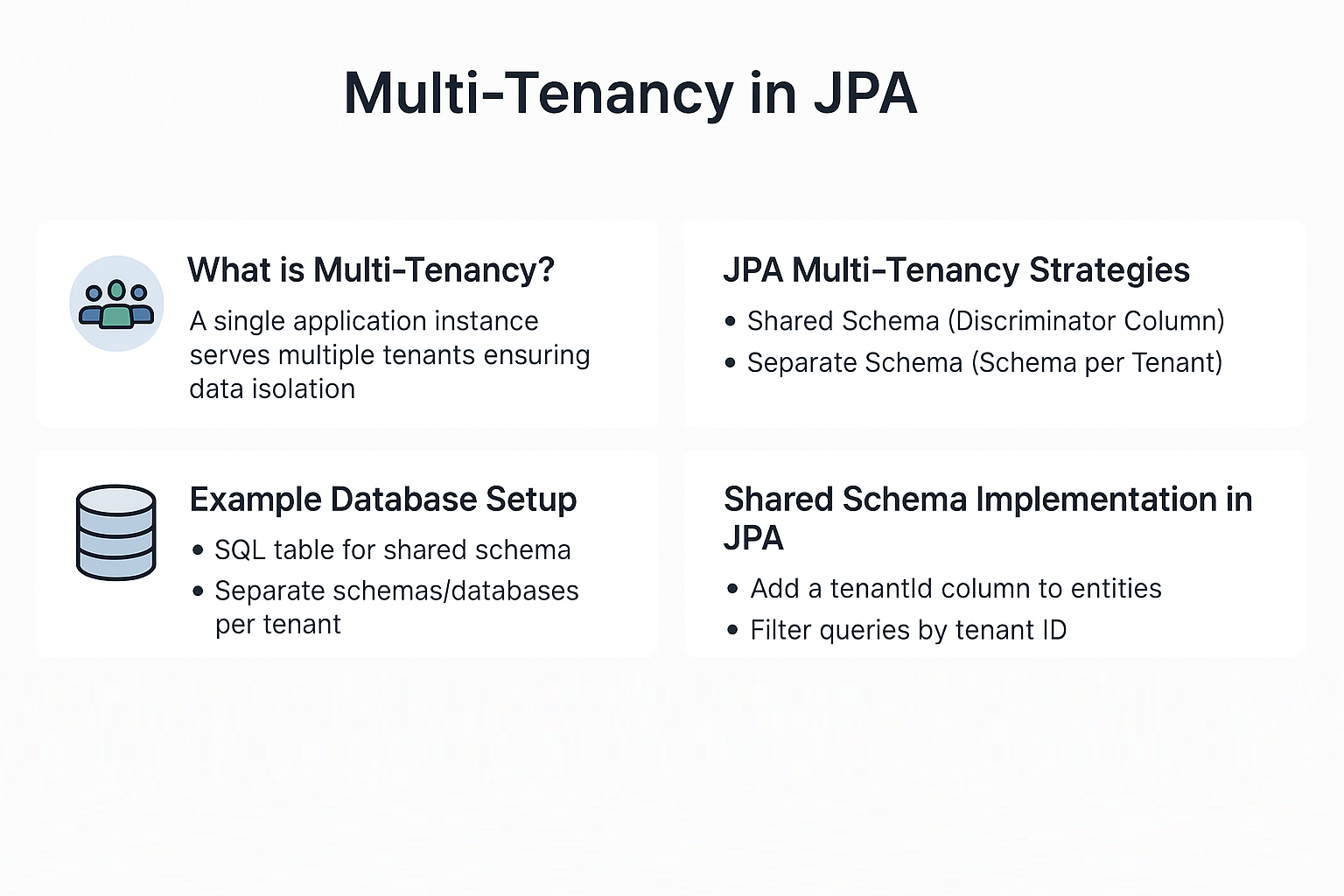As modern applications scale, supporting multi-tenancy becomes critical. Multi-tenancy means multiple tenants (clients, users, or organizations) share the same application but isolate their data. JPA provides flexible options to achieve this.
There are two primary strategies:
- Shared Schema (Discriminator Column): All tenants share the same schema, and data is separated using a tenant identifier column.
- Separate Schema (Schema per Tenant): Each tenant has its own schema or database.
This tutorial explores how to implement multi-tenancy in JPA with examples, performance considerations, and best practices.
1. What is Multi-Tenancy?
Multi-tenancy allows a single application instance to serve multiple tenants while ensuring data isolation and security.
Analogy:
- Shared Schema = Apartment building with shared walls but separate keys.
- Separate Schema = Independent houses for each tenant.
2. JPA Multi-Tenancy Strategies
2.1 Shared Schema (Discriminator Column)
- All tenants share one schema.
- A
tenant_idcolumn distinguishes tenant data. - Simple to manage but may affect query performance for large datasets.
2.2 Separate Schema
- Each tenant has its own schema or database.
- Provides stronger isolation and better performance at scale.
- Harder to manage migrations and resource usage.
3. Example Database Setup
Shared Schema
CREATE TABLE customers (
id BIGINT AUTO_INCREMENT PRIMARY KEY,
tenant_id VARCHAR(50),
name VARCHAR(100),
email VARCHAR(100)
);
Separate Schema
-- Schema for Tenant A
CREATE SCHEMA tenant_a;
CREATE TABLE tenant_a.customers (
id BIGINT AUTO_INCREMENT PRIMARY KEY,
name VARCHAR(100),
email VARCHAR(100)
);
-- Schema for Tenant B
CREATE SCHEMA tenant_b;
CREATE TABLE tenant_b.customers (
id BIGINT AUTO_INCREMENT PRIMARY KEY,
name VARCHAR(100),
email VARCHAR(100)
);
4. Shared Schema Implementation in JPA
Entity with Tenant Column
import jakarta.persistence.*;
@Entity
@Table(name = "customers")
public class Customer {
@Id
@GeneratedValue(strategy = GenerationType.IDENTITY)
private Long id;
private String tenantId; // tenant discriminator
private String name;
private String email;
}
Filtering by Tenant
List<Customer> customers = em.createQuery(
"SELECT c FROM Customer c WHERE c.tenantId = :tenant", Customer.class)
.setParameter("tenant", "tenant_a")
.getResultList();
5. Separate Schema Implementation in JPA
Dynamic Schema Switching
With Hibernate, you can set the schema dynamically using MultiTenancyStrategy.
spring.jpa.properties.hibernate.multiTenancy=SCHEMA
spring.jpa.properties.hibernate.multi_tenant_connection_provider=com.example.MultiTenantConnectionProviderImpl
spring.jpa.properties.hibernate.tenant_identifier_resolver=com.example.CurrentTenantIdentifierResolverImpl
Connection Provider Implementation
public class MultiTenantConnectionProviderImpl implements MultiTenantConnectionProvider {
@Override
public Connection getConnection(String tenantIdentifier) throws SQLException {
Connection connection = dataSource.getConnection();
connection.setSchema(tenantIdentifier); // switch schema dynamically
return connection;
}
}
Tenant Identifier Resolver
public class CurrentTenantIdentifierResolverImpl implements CurrentTenantIdentifierResolver {
@Override
public String resolveCurrentTenantIdentifier() {
return TenantContext.getCurrentTenant(); // thread-local tenant
}
@Override
public boolean validateExistingCurrentSessions() {
return true;
}
}
6. Real-World Integration with Spring Boot
Spring Boot + Hibernate makes tenant resolution seamless.
@Service
public class CustomerService {
@PersistenceContext
private EntityManager em;
@Transactional
public void createCustomer(String tenantId, String name, String email) {
TenantContext.setCurrentTenant(tenantId);
Customer c = new Customer();
c.setTenantId(tenantId);
c.setName(name);
c.setEmail(email);
em.persist(c);
}
}
7. Performance Considerations
- Shared Schema: Easier to maintain, but indexing
tenant_idis crucial for performance. - Separate Schema: Scales better but increases operational complexity.
- For both, caching strategies and connection pooling must be optimized.
8. Pitfalls and Anti-Patterns
- Mixing Tenants: Ensure tenant filters are always applied to avoid data leaks.
- Complex Migrations: Separate schema migrations can become costly.
- Excessive Eager Fetching: May degrade performance with large tenant datasets.
- Overusing Cascade: Avoid heavy cascades across tenant boundaries.
9. Best Practices
- Use shared schema for small/medium applications.
- Use separate schema for enterprise-scale apps requiring stronger isolation.
- Always enforce tenant filters in repositories or services.
- Implement automated migrations for schema-per-tenant setups.
- Monitor SQL queries to catch cross-tenant data access.
📌 JPA Version Notes
- JPA 2.0: Core ORM features, no built-in multi-tenancy support.
- JPA 2.1: Enhanced schema generation, useful for multi-tenancy setups.
- Hibernate Extensions: Added full multi-tenancy strategies (
DATABASE,SCHEMA,DISCRIMINATOR). - Jakarta Persistence (EE 9/10/11): Package rename (
javax.persistence→jakarta.persistence). No major multi-tenancy changes, but better cloud-native support.
Conclusion and Key Takeaways
- Multi-tenancy enables serving multiple clients in a single JPA application.
- Shared Schema = simpler, but less isolated.
- Separate Schema = more isolated, but harder to manage.
- Choose based on application scale, performance, and compliance needs.
FAQ (Expert-Level)
Q1: What’s the difference between JPA and Hibernate?
A: JPA is a specification, Hibernate is a provider that adds extended features like multi-tenancy.
Q2: How does JPA handle the persistence context?
A: JPA tracks managed entities in the persistence context, ensuring tenant isolation with filters or schema switching.
Q3: What are the drawbacks of eager fetching in JPA?
A: It loads unnecessary tenant data, hurting performance.
Q4: How can I solve the N+1 select problem with JPA?
A: Use fetch joins, entity graphs, or batch fetching.
Q5: Can I use JPA without Hibernate?
A: Yes, but Hibernate provides the richest multi-tenancy support.
Q6: Which multi-tenancy strategy is best for SaaS?
A: Shared schema for startups, separate schema for enterprise SaaS requiring strict isolation.
Q7: How does JPA handle composite keys?
A: Using @IdClass or @EmbeddedId annotations.
Q8: What changes with Jakarta Persistence?
A: Mainly package renaming and better cloud-native runtime alignment.
Q9: Is JPA suitable for microservices?
A: Yes, but tenant context resolution must be lightweight.
Q10: When should I avoid JPA multi-tenancy?
A: Avoid it in apps with few tenants where a single schema is simpler to manage.
